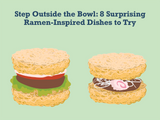
I've shared several recipes on making ramen, ramen broth, and ramen alternatives.

While we use only the tools readily-available at home, what about ramen chefs in a professional setting?
Let's take a look at this interesting, but rarely talked about topic!
Here are 7 professional (but basic) tools that all ramen restaurants in Japan will have:
1. Zundo (寸胴)

The approximate size of a zundo is 21 inches in diameter, 21 inches in height, with a capacity of 32 gallons.
In Japanese, a zundo originally meant “a torso with no waist”, later the meaning changed to just meaning a cylindrical shape.
2. Gas stove (ガスコンロ)

Professional gas stoves have dual or triple-ring heating plates in order to heat the contents in the zundo efficiently.
3. Tebo (テボ)

Using more than one tebo at a time allows the chef to boil noodles for many customers at the same time.
One bowl’s portion of noodles fits in one tebo, this way, you don’t need to spend time separating cooked noodles into different bowls. Also, using a tebo allows the chef to adjust the “chewiness” of the noodles specific to the order.
However, if you are not careful when using a tebo, the noodles can stick to the inside of the tebo since the noodles are “caged” and there is little room for the noodles to move around in the boiling water.
4. Hirazaru (平ざる)

Noodles boiled this way are heated evenly in contrast to noodles heated using the tebo. The taste of noodles heated in the hirazaru is different and often times better than the noodles boiled in the tebo.
5. Hishaku (柄杓)

A wooden ladle which you can also find at a shinto shrine (which you use when you wash your hands and rinse your mouth).
At a ramen restaurant, a chef will use the hishaku to scoop soup into a ramen bowl.
6. Zaru (ざる)

It is a strainer for cooking ramen and it looks like a lacrosse racket. Chefs use this in order to get rid of small pieces of meat, vegetables and bones that were boiled to make the broth.
When chefs pour soup into ramen bowls, they use this as a filter. Some restaurants use coarse strainers on purpose to add little pieces of meat, vegetables, and other residues from the broth to show the diner what went into the broth. The fineness of this strainer depends on the chef's preference.
7. Ladle (レードル)

It measures, scoops and pours tare (sauce) into a bowl of ramen. The size of the ladle is dependent on the sauce. If a thin sauce is used, you use larger ladle, and if the sauce is salty, you use small one.

Now that we're a little more familiarized with some of the professional ramen tools, have you noticed that there ramen chefs use so many types of different strainers?
There is actually a very important skill that is needed when using these strainers.
The skill is called “Yugiri" (湯切り) which literally means “cutting" hot water.

Did you think it looked a little dramatic or theatrical?
While some people might think that this is just for performance, there are some reasons why yugiri is practiced:
1. It prevents dilution of the soup
Ramen chefs put a lot of effort into making their broth. It takes many hours to boil a pot of broth to perfection.If you don’t properly drain the water from the noodles, residual water from the noodles will be added into the broth and the chef's effort will be ruined.
At a ramen restaurant, every chef learns the same draining technique to keep the quality of the soup the same.
For example, the number of times they swing the tebo, the angle of the strainer, what height to start at, etc..
There really is an art to the usage of strainers in the ramen world!
2. It gets rid of the noodle’s stickiness
Flour is added to the noodles to prevent them from sticking to each other when they are stored. This flour makes the boiled noodles' surface a little slimy and slippery.In order to get rid of this sliminess, you will need to drain very hard.
Have you heard of the yugiri method and did you know about these reasons previously?
Although many different types of drainers are used when chefs prepare their ramen, the two main types of strainers used for yugiri is:
The Tebo Strainer and The Hirazaru Strainer
Almost all ramen restaurants use either one of these strainers to drain water.
The shapes of these two strainers are completely different and each have their own pros and cons.
The tebo is very efficient and easy to use. It has room for one serving of ramen, so one tebo can hold and cook for each customer.
You can put multiple tebo strainers in the same pot of boiling water, so you don't have to separate the cooked noodles into separate bowls.
You can also easily adjust the chewiness of the noodles by setting a timer beside each tebo.
On the other hand, a hirazaru is not as efficient as the tebo. Once you boil noodles in a pot of boiling water, you can't add noodles into it until the first batch is completed. This is because you won’t be able to distinguish which ones were from the first batch and which one is from the latter.
You would have to wait until the first batch is done before you can add more noodles. This means customers will have to wait longer for their ramen.
However, when professionals use hirazaru, the texture of the noodles are better since noodles can move freely in the pot of boiling water. This ensures that heat can be evenly distributed allowing the noodles to be evenly cooked.
Using the tebo is convenient, however, the noodles are “caged” in the strainer. Because, the noodles are "balled up", it is possible that the middle section can be a little less cooked than the rest of the noodles.
In ramen restaurants that have been running their businesses for a long time, or stores where owners are obsessed with ramen, they tend to use the hirazaru.
These owners think the taste of the finished product comes first while efficiency and profit comes next. There are definitely benefits to using the hirazaru, however, it requires a lot of practice.
Modern ramen restaurants or budget ramen stores that pride themselves on value and affordability often times use the tebo since customers can choose the chewiness of the noodles at these restaurants.
They also have to hire part timers, and tebo usage is much easier to teach in contrast to the hirazaru.
What about when making ramen at home? Do you have a tebo or a hirazaru?
I personally use just a regular drainer (whatever I have at home).
Whatever strainer or draining method you use at home, no Japanese home-cooked ramen is complete without an authentic Japanese ramen bowl to recreate the atmosphere and feeling similar to the one you had while traveling in Japan.
We can help you out with that! Take a look at some of our most popular choices!




Leave a comment